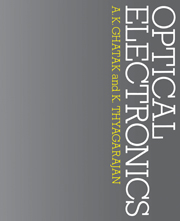Book contents
- Frontmatter
- Contents
- Preface
- 1 Maxwell's equations and propagation of electromagnetic waves
- 2 Reflection and refraction of electromagnetic waves
- 3 Wave propagation in anisotropic media
- 4 Fraunhofer diffraction
- 5 Fresnel diffraction
- 6 Spatial frequency filtering
- 7 Holography
- 8 Lasers: I
- 9 Lasers: II
- 10 Some laser systems
- 11 Electromagnetic analysis of the simplest optical waveguide
- 12 Leaky modes in optical waveguides
- 13 Optical fibre waveguides
- 14 Integrated optics
- 15 The electrooptic effect
- 16 The strain optic tensor
- 17 Acoustooptlc effect: Raman–Nath diffraction
- 18 Acoustooptic effect: Bragg diffraction
- 19 Acoustooptic devices
- 20 Nonlinear optics
- Appendices
- References and suggested reading
- Index
14 - Integrated optics
Published online by Cambridge University Press: 05 June 2012
- Frontmatter
- Contents
- Preface
- 1 Maxwell's equations and propagation of electromagnetic waves
- 2 Reflection and refraction of electromagnetic waves
- 3 Wave propagation in anisotropic media
- 4 Fraunhofer diffraction
- 5 Fresnel diffraction
- 6 Spatial frequency filtering
- 7 Holography
- 8 Lasers: I
- 9 Lasers: II
- 10 Some laser systems
- 11 Electromagnetic analysis of the simplest optical waveguide
- 12 Leaky modes in optical waveguides
- 13 Optical fibre waveguides
- 14 Integrated optics
- 15 The electrooptic effect
- 16 The strain optic tensor
- 17 Acoustooptlc effect: Raman–Nath diffraction
- 18 Acoustooptic effect: Bragg diffraction
- 19 Acoustooptic devices
- 20 Nonlinear optics
- Appendices
- References and suggested reading
- Index
Summary
Introduction
Integrated optics is a new and exciting field of activity which is primarily based on the fact that light can be guided and confined in very thin films (with dimensions ∼ wavelength of light) of transparent materials on suitable substrates. By a proper choice of substrates and films and a proper configuration of the waveguides, one can perform a wide range of operations such as modulation, switching, multiplexing, filtering or generation of optical waves. Due to the miniature size of these components, it is possible to obtain a high density of optical components in space unlike the case in bulk optics. These devices are expected to be rugged in construction, have good mechanical and thermal stability, be mass producible with high precision and reproducibility, and have a small power consumption.
One of the most promising applications of integrated optics is expected to be in the field of optical fibre communications. As discussed in Chapter 13, the field of optical fibre communication has assumed tremendous importance because of its high information-carrying capacity; it is here that integrated optics is expected to play an important role in optical signal processing at the transmitting and receiving ends and on regeneration at the repeaters. Other important applications of integrated optics are envisaged to be in spectrum analysis (see Chapter 19) and optical signal processing.
In addition to the above, use of integrated optic techniques may lead to the realization of new devices which may be too cumbersome to be fabricated in bulk optics.
- Type
- Chapter
- Information
- Optical Electronics , pp. 421 - 460Publisher: Cambridge University PressPrint publication year: 1989



